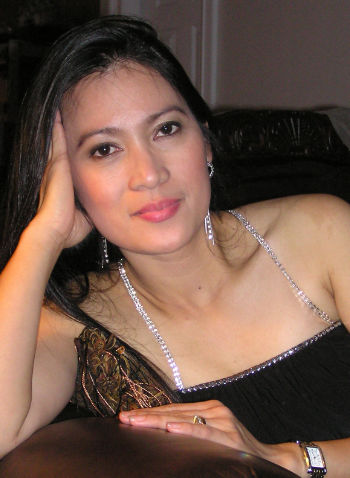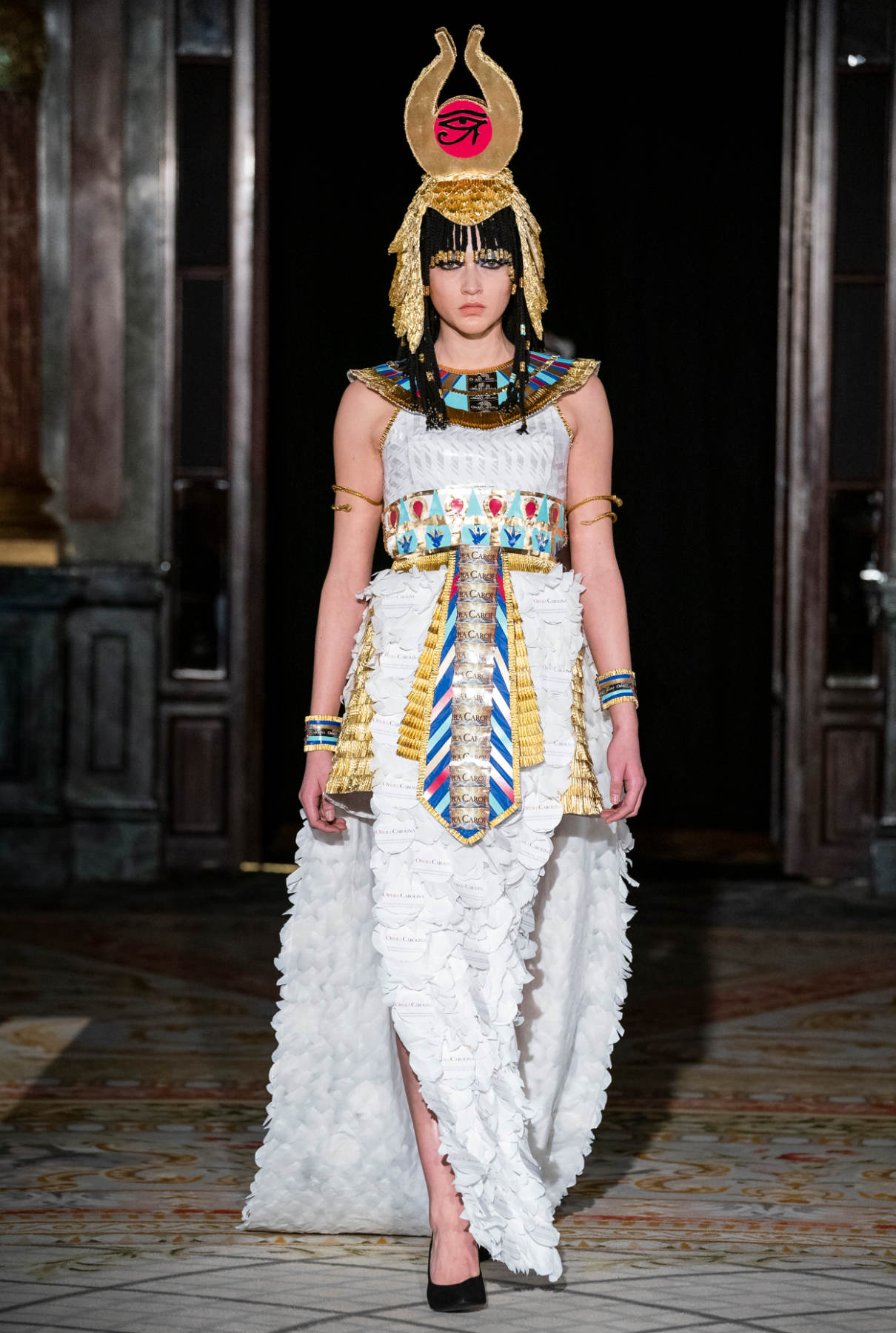Designers Make High Fashion Eco-Friendly
From Charlotte to the Paris Runway
BY SUSAN PALMES-DENNIS
Rather than make dresses using the finest and most expensive materials, two Filipino American designers are setting a laudable trend in the demanding, discriminating world of global fashion by recycling materials and converting them into eye-catching, eco-friendly clothing.
Malou Tabada Cordery and Edelweiss de Guzman Vogel — both from Charlotte, North Carolina — made their mark in 2019 at the Spring Fashion Week at the InterContinental Paris le Grand hotel and they continue to make waves with their eco-couture works two years after that high profile fashion event.
Malou Tabada Cordery
 Malou Tabada Cordery, a mainstay in the Charlotte fashion design industry for nearly 15 years, made such creations as the ‘Aida’ dress, an outfit made of a lab gown, disposable table cloth and old paper brochures that drew inspiration from the opera Aida by Guiseppe Verdi and showcased in the Spring Fashion Week in Paris.
Malou Tabada Cordery, a mainstay in the Charlotte fashion design industry for nearly 15 years, made such creations as the ‘Aida’ dress, an outfit made of a lab gown, disposable table cloth and old paper brochures that drew inspiration from the opera Aida by Guiseppe Verdi and showcased in the Spring Fashion Week in Paris.
Armed with the historical knowledge of Aida as an Ethiopian princess with a great love story, Malou was inspired to create Aida’s outfit in a style reflecting that period in time using recyclable materials mostly sourced from the hospital she works in. As told in the opera. Aida was held captive in Egypt and fell in love with General Rameses who was torn between his love of Aida and his loyalty to the Pharoah.
‘Aida is a timeless story of love and betrayal against the backdrop of war. I was inspired to create Aida's outfit in my own style, which is more about fashion than costume. I've have to work around my work schedule to finish it,” she said.
While unable to attend the Paris Spring Fashion Week, Malou’s Aida-inspired gown was modeled by Molly Estellia Davidson of England and received acclaim from the audience. Malou had been active in the Charlotte fashion scene, headlining such events as the Charlotte Seen’s Passport for Fashion in February 2016 and the Catwalk for Cookies Charity.
Malou was awarded Best Recyclable Designer and ranked first in the People’s Choice Award. Malou was featured in the Elysian Magazine and Opera America magazine. Malou also participated in major fashion events in New York.

Edelweiss De Guzman-Vogel
 Edelweiss De Guzman-Vogel is a visual artist, freelance designer, and educator. She is teaching visual art at The Brawley, an IB World School. Edelweiss started showcasing her eco-friendly dresses in 2011 and won a few awards from Charlotte Fashion Week and Gaston Arts Council. In 2015 she co-founded a group called The Art Ecologie Group, which advocates for sustainable use of recyclable materials in art and fashion through events like the annual Eco-Fab Couture-crafted outfits ‘The Red Stark’. It was made from old magazines and flyers from Opera Carolina and is styled in the exaggerated grandeur of the Baroque period.
Edelweiss De Guzman-Vogel is a visual artist, freelance designer, and educator. She is teaching visual art at The Brawley, an IB World School. Edelweiss started showcasing her eco-friendly dresses in 2011 and won a few awards from Charlotte Fashion Week and Gaston Arts Council. In 2015 she co-founded a group called The Art Ecologie Group, which advocates for sustainable use of recyclable materials in art and fashion through events like the annual Eco-Fab Couture-crafted outfits ‘The Red Stark’. It was made from old magazines and flyers from Opera Carolina and is styled in the exaggerated grandeur of the Baroque period.
The ‘Red Stark’s’ bodice — worn by French model Claudia Thomson who Edelweiss personally picked upon her arrival for the fitting — is made of papier-mâché sculpture. Edelweiss said she learned the technique in making the bodice from the Philippines. "I used the overlapping elements in the composition which is distinct to the Baroque style," Edelweiss said.
To give it an exaggerated look and highlight the dramatic details, the artist in Edelweiss used bright red for the entire dress and created a big white headdress sculpture made of Bristol board or heavy paper. Edelweiss said the Baroque period is characterized by an overly-exaggerated motion and grandeur as found in the sculptures, paintings, literature, and music of that time. On the other hand, Edelweiss’s ‘Purple Illusion’ is inspired by the Expressionist movement.
Edelweiss said the ‘Purple Illusion’ is a homage to expressionist film and theater as it used form, line, spatial distortion, intense surface texture and rich color juxtapositions to capture emotional response.
She said the expressionist style reminded her of American filmmaker Tim Burton who combined the grotesque or strange with whimsical and childlike elements. The “Purple Illusion” piece is worn by model Elizabeth Victoria. Edelweiss remains more than just a presence in various local fashion shows using recyclable materials.

PHOTOGRAPHER: FRANK DENIS
The creations of both Malou and Edelweiss continue to draw raves from the fashion crowd in Paris and abroad and they hew closely to their traditional Filipino roots while embracing the modern era. Their success showed that high fashion need not be overly priced and consume costly materials that would otherwise be disposed off and dumped in the nearest waste bin once the audience leaves and the runway lights are turned off.
